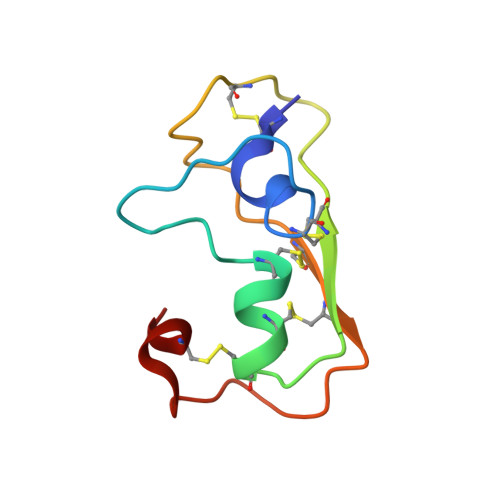Macin family of antimicrobial proteins combines antimicrobial and nerve repair activities.
Jung, S., Sonnichsen, F.D., Hung, C.W., Tholey, A., Boidin-Wichlacz, C., Haeusgen, W., Gelhaus, C., Desel, C., Podschun, R., Waetzig, V., Tasiemski, A., Leippe, M., Grotzinger, J.(2012) J Biological Chem 287: 14246-14258
- PubMed: 22396551
- DOI: https://doi.org/10.1074/jbc.M111.336495
- Primary Citation of Related Structures:
2LN8 - PubMed Abstract:
The tertiary structures of theromacin and neuromacin confirmed the macin protein family as a self-contained family of antimicrobial proteins within the superfamily of scorpion toxin-like proteins. The macins, which also comprise hydramacin-1, are antimicrobially active against Gram-positive and Gram-negative bacteria. Despite high sequence identity, the three proteins showed distinct differences with respect to their biological activity. Neuromacin exhibited a significantly stronger capacity to permeabilize the cytoplasmic membrane of Bacillus megaterium than theromacin and hydramacin-1. Accordingly, it is the only macin that displays pore-forming activity and that was potently active against Staphylococcus aureus. Moreover, neuromacin and hydramacin-1 led to an aggregation of bacterial cells that was not observed with theromacin. Analysis of the molecular surface properties of macins allowed confirmation of the barnacle model as the mechanistic model for the aggregation effect. Besides being antimicrobially active, neuromacin and theromacin, in contrast to hydramacin-1, were able to enhance the repair of leech nerves ex vivo. Notably, all three macins enhanced the viability of murine neuroblastoma cells, extending their functional characteristics. As neuromacin appears to be both a functional and structural chimera of hydramacin-1 and theromacin, the putative structural correlate responsible for the nerve repair capacity in leech was located to a cluster of six amino acid residues using the sequence similarity of surface-exposed regions.
- Institute of Biochemistry, Zoophysiology, Christian Albrechts University of Kiel, Olshausenstrasse 40, 24098 Kiel, Germany.
Organizational Affiliation:
















